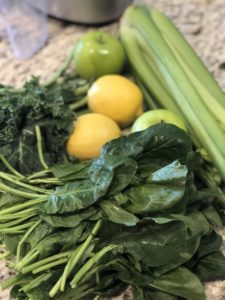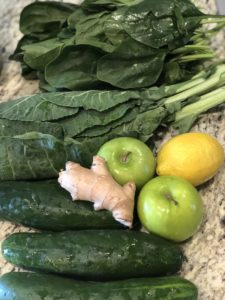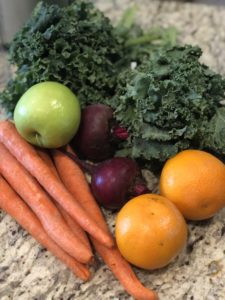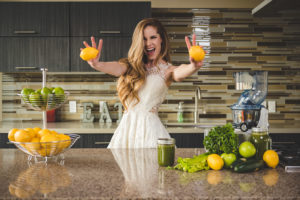When I first started juicing back in 2014, I didn’t have “recipes” I followed…I just started throwing stuff in a juicer following a few simple rules. Over time, throwing some stuff together eventually resulted in a few of my favorite juice combos!
Whether you want to follow a recipe or just wing it like me, here are some tips you definitely want to follow when you juice:
- Always make your juice from primarily vegetables, a 90/10 ratio is a good rule of thumb
- Always use lots of green leafy vegetables in your juice. A few of my favorites are kale, spinach, and green collards
- Regardless of what you decide to put in your juice, throw in a lemon and a green apple and you will end up with a decent flavor
- Make sure to rotate the vegetables you juice to get a variety of nutrients
- Peel citrus fruits before putting them in a juicer
- Avoid fruits like berries and bananas
- Less is more with the quantity of vegetables and fruits you use, try to stick to 4-5 ingredients!
Over the years I’ve created some good juice combos and some…um, not so good combos. I’ve enjoyed experimenting on my juicing journey to see what I can come up with. Play around with it, and I’m sure you will find some combos you like too! While some juice combos definitely taste better than others, keep in mind the purpose of juicing isn’t necessarily for flavor, but for HEALTH!
To help get you started, here are a few recipes to try! (And yes, I made up the names as I went.)
- 1 bunch spinach
- 2 bunches of kale
- 8 stalks of celery
- 2 green apples
- 3 lemons
Green Machine

- 2 bunches of green collards
- 1 bunch of spinach
- 2 green apples
- 3 cucumbers
- Approx 1-2″ fresh ginger root
- 1 lemon
Everybody Loves Ginger

- 2 bunches of kale
- 2 beets
- 7 carrots
- 2 oranges
- 1 green apple
I’m All About My Beets

Juices with beets are definitely my least favorite (this is where I remind myself it’s for health not for flavor), but since beets have such great health benefits I always cycle them through my juicing. I also don’t eat beets, ever, so juicing them is the only way my body gets to benefit from their powerhouse of nutrients.
Each recipe made two 32oz. jars of juice. You will likely want to half each recipe, that will give you a cup of fresh green juice to start your day for a couple of mornings as long as you store it correctly! Keep in mind fresh pressed juice only stays good for up to 24-72 hours after juicing, don’t make more than you can get through. The juice will always taste the best and have the greatest nutritional value within the first 2 hours of making it. When I can, I like to make my juice first thing in the morning so I can drink it FRESH! I promise it doesn’t take that long, from start to clean up it takes me about 20 minutes.
Additional Juicing Tips:
- Drink your juice first thing in the morning on an empty stomach to get the most benefits, wait 20 minutes before eating.
- Buy organic produce to juice!
- ALWAYS clean your juicer immediately after use, I promise it makes clean up 10x easier. If the pulp hardens in the screen, it’s game over as far as clean up goes.
- Clean the screen thoroughly, don’t leave anything stuck in there.
- Yes, your juicer can affect the shelf life of your juice!
- I’ve switched over to a slow juicer (also known as a cold press juicer) since it produces very little to no heat during the juicing process which ultimately means no oxidation takes place and will extend the storage life of the juice (up to 72 hours if stored correctly.) Why does it matter if oxidation is happening while juicing? Oxidation affects the freshness of your juice and may eliminate some of the nutritional value so that, even over a short period of time, there may be none left at all.
- We just bought this Breville slow juicer! Both juicers I’ve had have been Breville, can’t say enough good about that brand, great quality! The first one I had lasted well over 5 years!
- Store your juice in glass, not plastic, plastic will speed up the oxidation process. I recommend buying a case of 32oz. mason jars, they seal tightly which helps with preventing oxidation while storing.
- Fill your glass container as full as possible, leaving little to no room for air
- I always try to use vegetables I don’t enjoy eating or have a hard time fitting into my die. There’s lots of amazing vegetables that I don’t eat on a daily basis, so I get their nutrients by juicing them. Example: Beets, dandelion greens, butternut squash, collard greens are vegetables I don’t eat frequently (or ever) in my diet, but I rotate them in my juice often.
Remember, just because you’re juicing and getting all these amazing nutrients from vegetables first thing in the morning, don’t forget to eat plenty of veggies throughout the day! The benefits of eating vegetables in your diet is equally as important as the benefits you get from juicing them.
Juiced vegetables are beneficial mainly because you’re consuming raw food products. When you bake, boil, pickle or stew, you can lose antioxidants and other nutrients. However, juicing vegetables means that the skin, and consequently the fibrous part of these foods, is lost in the juicing process. Fiber is important for the function of your digestive system and helps regulate your blood sugar. When you eat raw vegetables, you get the beneficial fiber and all the other health-promoting nutrients.
Moral of the story, MORE VEGGIES ALL AROUND!
If you want to know what got me started on my juicing journey, I recommend watching Hungry for Change on Netflix. I distinctly remember watching that in 2014 and immediately diving into the juicing world. Starting my day with fresh pressed juice has become one of my favorite parts of my morning routine.
Last but not least, HAVE FUN!

